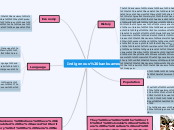Landform Region Inquiry
Environmental
How was the Landform region created
Formed from plate collision and folding
with the European plate and North American plate
Sediments being compressed over the
years turned into land
The Western Cordillera formed when the Pacific and the North American plates collided. The Pacific plate subducted under the North American plate which caused folding, creating the Rockies, Columbia and Coast Mountains
What species of animals live here?
White-tailed deer, American black bear, beaver,
squirrel, raccoon
Mule deer, Pronghorn, Brown bear,
Gray wolf, Elk
Some species include Mountain Goat, Moose, Caribou, Deer are common.Rocky Mountain Elk, Bighorn Sheep, Stone Sheep are less frequently found. Grizzly Bears and Black Bears are the most common large mammals.
Economic
How are the prices of living affected?
In the Appalachians it costs about 4,050C$ for a four-person family monthly. Also has a cost of living index of 79.8.
In the Interior Plains it costs about 2,090C$
for a four-person family monthly.
In British Columbia a four person family monthly costs about 2,000C$. Also has a cost of living index of 74.5
What kinds of jobs are available?
Coal mining, fishing, and lumber
Some of the occupations are farming, forestry, mining, and the oil and gas industries
Some jobs include, lumber, fishing, coal and petroleum mining
Social
How does this region fit peoples needs
There are no hospitals in the Canadian region, no health care, one school in Newfoundland called “Appalachia High School”
There is lots of flat land for farming
and building of communities, lots of health care/hospitals
and a normal amount of schools
This place has many mountains rivers and grasslands but also has an ocean. This place has some great views of the mountains and the ocean. Two main cities are Vancouver and Victoria
What is the Population
There is a population of 25 million people in the Appalachian Mountains
Estimated around 4,811,893
The population of the Cordilleras is estimated to be around 4 850 000 as of today
Vegetation
How does the vegetation affect the environment
The environment isn’t affected by the vegetation, the trees can survive in the poorest quality soil, when they live by rivers the soil is much richer making the trees there healthier
The fields have food for wild life as well as habitats for them as well
The vast forest provide great habitats for many different species. But the mountains prevent interior forests to see the ocean as a water source and food source
What kinds of trees grow?
Sugar maple, Beech, Eastern Hemlock, Eastern White Pine, Acer spicatum and etc
Deciduous, Boreal, Columbia, and grassland
Most of the trees that grow there are Douglas Fir, Lodgepole Pin, Alpine Fir, Western Red Cedar, Western Hemlock, Sitka Spruce, and Trembling Aspen
Soil
How fertile is the soil?
Mountain soil is very fertile because it takes all the run off from the mountain like organic deposits, and river deposits and collects in the valley
The Interior plains are full of deep fertile soil
The soil is fertile due to the heavy rainfall and mountain moisture. But the soil gets worse as you go up the mountain due to the cold icy mountains
What types of soil is found there?
the soil is rich, the soil is “loamy”, and a mixture between clay, silt, and sand, the soil is “acidic”, has a drained and brown color
The soil is deep and able to produce an
abundant amount of crops/vegetation
There are many different types of soil found here because of the differences in climates between locations, but the most popular is podzol soils, which are acidic and don't have humus. But since it rains alot plants can grow in the area
Climate
How does the climate affect vegetation?
Longer growing seasons, increasing water temperatures, increased heat frequently, increased evapotranspiration by vegetation and in streams
up North is Tundra, which is treeless area where the ground is always frozen, in the Prairies there are tall grasses and even some that can grow to the height of a person
The climate here is very complex due to elevation and mountains that block air flow. On the ground lush healthy plants grow due to lots of rainfall. However because of the icy cold weather on the mountains very few trees can survive. The higher the elevation the less vegetation.
What is the climate like?
Average of 10C up north and 18C down south
Long cold winters and short, hot summers
the precipitation in the interior plains is between
300 mm and 500 mm on average
Alberta
The winters are usually above freezing so there is not usually much snow fall. The summers in this region are cool, but the temperature varies greatly because of the mountains. Locations only a few kilometers apart may have very different temperatures and precipitation patterns
Prince George
Vancouver
Location
How does living here provide advantages/ disadvantage?
Advantages, Coal Mining, Fishing, Tourism
Disadvantages, living in the “hollows” accessible by one lane roads, school, work and medical are harder to access
Advantages, Farming, Oil Mines, and mineral mines
Disadvantages, Lack of communities
Some of the advantages to the Western Cordilleras are the
easy access to fish and shipping docks being a coastal region, Some disadvantages are the cold climate and mountain ranges for restricted building
Where it is?
Appalachians
Eastern Canada surrounding
New Brunswick, Nova Scotia, PEI
and New Foundland and Labrador
Interior Plains
Western Canada and the prairies
surrounding Alberta, Manitoba, NWT,
and Saskatchewan
Western Cordillera
The Western Cordilleras are located on the West Coast of Canada in British Columbia. There are 3 regions, the Eastern Mountains, the Interior Plateaus, and Coast Mountains.









